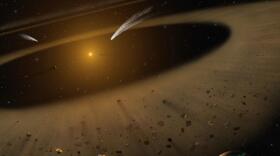Our existence has an expiration date
From black holes, imploding stars and our sun swallowing our planet, there are a ton of ways life as we know it could end.
Aside from asteroids and floating space debris colliding with our planet, Walkabout the Galaxy’s Josh Colwell said one way our world could end is when our Earth dies. While that’s not going to happen in this millennium (hopefully), Colwell said the Earth will “become a sort of a dry, unlivable greenhouse world, and that's in about a billion years.”
While Colwell said that uninhabitable Earth is terrifying, the end of the universe is a sad subject for him as well. As stars die and distant galaxies cease to exist, the night sky will look quite different.
“I find it troubling is that in another something on the order of 100 billion years, the expansion of the universe will carry everything that we see in these beautiful pictures that we get from telescopes like the Hubble Space Telescope and James Webb Space Telescope of distant galaxies and clusters that will be carried beyond the limits of the observable universe,” Colwell said. “In the distant future, the only thing that will be within the observable universe that we can see is our current local group of galaxies, the Milky Way.”
While it has been thought that the end of the world would happen way into the future, new theories suggest that the world could end sooner. According to Walkabout the Galaxy’s Jim Cooney, the theories about the end of our world came from Stephen Hawking.
“Recently, people have been suggesting that perhaps this kind of Hawking radiation that will evaporate black holes may also work on white dwarfs and neutron stars,” Cooney said. “Not everybody agrees, but if that is true, then we can get rid of those things. Then that means, the end of the universe can come and in some reasonable amount of time.”
Stopping cell death, on Earth and in space
As humans venture deeper into space on long-duration missions to places like the moon and Mars, scientists are trying to protect the human body from the effects of space travel.
Necrosis, or abnormal cell death from external factors like toxins or trauma, is something that impacts humans here on Earth.
Researchers believe understanding and combating it could play a role in long-duration missions. Carina Kern, the CEO of LinkGevity an AI enabled drug discovery company, said the environment of space changes the pace of necrosis and its impacts.
“In space, you have certain factors which cause a type of magnifying glass for tissue degeneration,” Kern said. “So, you have cosmic radiation and microgravity, and these compound the same stressors that you have on Earth, resulting in degeneration on a much faster pace.”

While it is being studied on our planet, Kern said it’s important to push the frontiers of this research into space.
“We saw the revolution when it came to the engineering space, from the mundane to the breakthroughs,” Kern said. “From your scratch-proof glass to microchips. I think the potential from studying a process like necrosis in space to then bringing back revolutionary interventions from Earth is vast.”
Because necrosis is a complicated issue to fix in the human body, Kern said nothing has been discovered that could fix it. However, Kern said there may be a way to slow it down.
Using an AI enabled drug discovery engine, Kern said “it gave us inroads into how you can block necrosis, and the answer here was hitting different targets within the cell simultaneously. What is exciting is, when we've done this, we're seeing around a 90% to 100% inhibition of necrosis across tissues and across diverse stressors.”







